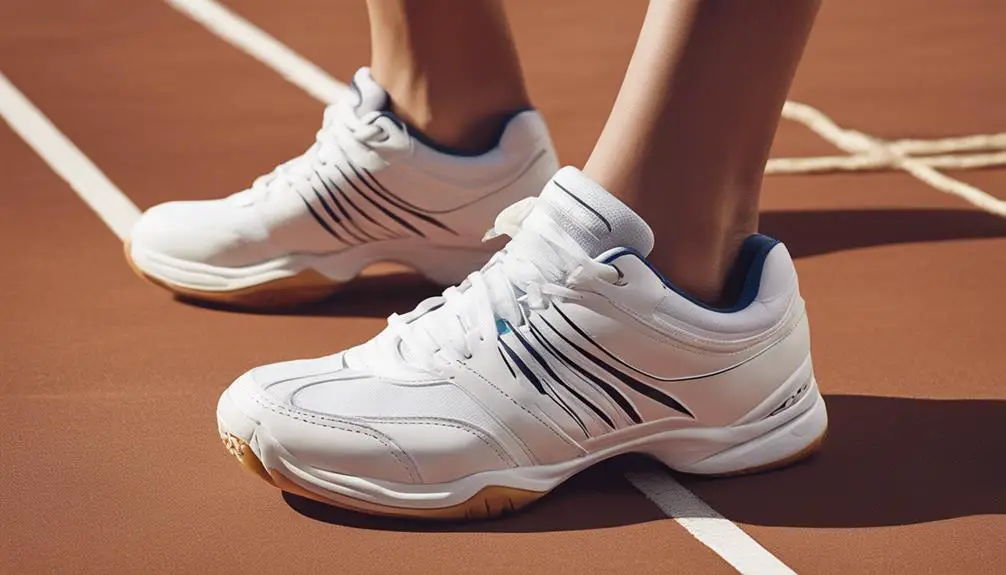Tennis and badminton shoes are designed specifically for each sport’s unique requirements. Tennis shoes prioritize lateral stability for quick side-to-side movements, featuring thicker cushioning for impact protection on various court surfaces. In contrast, badminton shoes focus on lightweight design, prioritizing agility and flat, gum rubber soles for maximum grip on indoor courts. They offer moderate cushioning, enhancing responsiveness during rapid jumps. Additionally, tennis shoes provide more ankle support, while badminton shoes allow for greater mobility. Understanding these differences can help you choose the right shoe for peak performance and comfort on the court. Discover more about the specifics of each shoe type.
Purpose of Sport-Specific Shoes
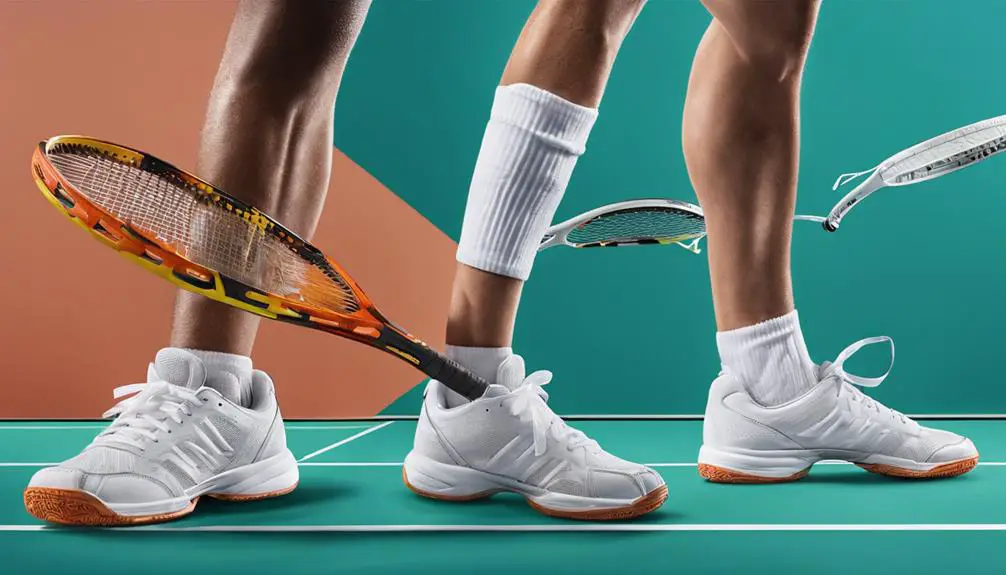
Understanding the purpose of sport-specific shoes is essential for enhancing performance and preventing injuries. When you choose shoes tailored for tennis or badminton, you’re considering the unique demands of each sport. These shoes are designed to meet specific sport requirements, guaranteeing that you’ve got the right support and traction for peak shoe performance.
In tennis, for instance, the need for lateral stability is critical. The game involves quick side-to-side movements, and a shoe that provides adequate ankle support and cushioning can help prevent sprains and strains. The outsole is engineered for durability on hard courts, offering a balance between grip and slide, allowing you to pivot effectively without compromising speed.
On the other hand, badminton requires a different approach. The fast-paced nature of the game calls for lightweight shoes that enhance agility and speed. The grip must be excellent on indoor courts, where rapid direction changes are common. Badminton shoes usually have a softer outsole to provide better traction without leaving marks on the court surface. This focus on lightweight design guarantees that you can move swiftly without feeling weighed down.
Sole Design Differences
The sole design of tennis and badminton shoes plays an important role in their performance characteristics, reflecting the specific movements and surfaces associated with each sport. When you’re on the court, your shoe’s grip and stability are essential for executing quick lateral movements. Tennis shoes often feature a herringbone tread pattern, which provides traction on various court surfaces, whether it’s clay, grass, or hard court. This design allows you to pivot and slide effectively while maintaining balance.
On the other hand, badminton shoes typically use a gum rubber sole for maximum grip on indoor court surfaces. The sole is designed to be non-marking, so it won’t leave scuff marks during play. This is critical in badminton, where quick, agile movements and rapid changes in direction are key. The sole may also be thinner and more flexible, promoting a closer-to-ground feel, which enhances your control and responsiveness.
Additionally, shoe fit is important for both sports. A snug fit reduces the chance of slipping inside the shoe, which can lead to injuries. Tennis shoes may be slightly bulkier to accommodate the foot’s lateral movements, while badminton shoes prioritize a lightweight construction for speed and agility. Ultimately, understanding these sole design differences helps you choose the right footwear, ensuring that you can play your best while enjoying the freedom of movement each sport offers.
Cushioning and Shock Absorption
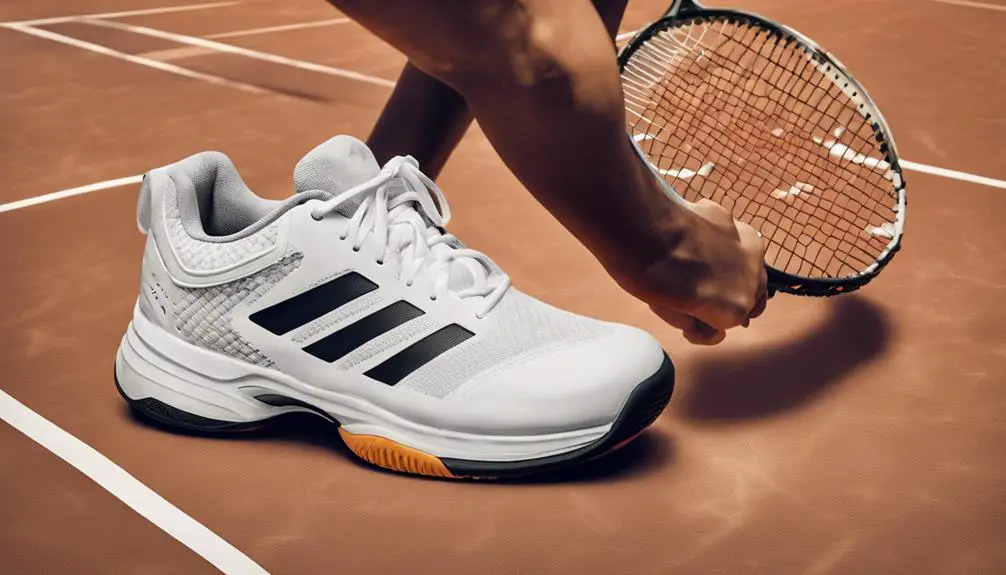
When it comes to cushioning and shock absorption, the differences between tennis and badminton shoes are vital for maximizing performance on the court. Each sport demands unique movement patterns and impact forces, which directly influence shoe design. Here’s what you should consider:
- Cushioning Material: Tennis shoes often feature thicker cushioning made from EVA or polyurethane, providing a plush feel suitable for longer rallies. Badminton shoes, while also cushioned, focus more on responsiveness, using lighter materials for quick lateral movements.
- Arch Support: The arch support in tennis shoes is typically more pronounced to accommodate the extended periods of play and the need for stability during serves and volleys. In contrast, badminton shoes offer moderate arch support, as the emphasis is on agility and rapid direction changes.
- Impact Protection: Tennis shoes prioritize impact protection, especially in areas prone to stress, like the heel and forefoot. Badminton shoes, on the other hand, are designed to absorb impact from quick jumps and rapid footwork, ensuring your feet remain comfortable and injury-free during intense matches.
Understanding these distinctions is imperative. Opting for the right shoe not only enhances your performance but also protects you from potential injuries. So, whether you’re smashing a shuttlecock or serving an ace, make sure your footwear aligns with your sport’s demands for ideal cushioning and shock absorption.
Support and Stability Features
How do support and stability features differ between tennis and badminton shoes? When you’re playing tennis, your movements are often lateral and involve quick changes in direction. As a result, tennis shoes are designed with enhanced lateral stability. This is essential for maintaining balance during those rapid side-to-side motions. You’ll find that tennis shoes typically have a broader base and a reinforced upper, which helps keep your foot secure, preventing unwanted movement that could lead to injuries.
On the other hand, badminton requires a different approach. The game involves a lot of quick, explosive movements and vertical jumps. While badminton shoes also provide lateral stability, they focus more on flexibility and lightweight design to support those rapid, agile plays. The outsole treads are specifically designed for quick grip and release to facilitate swift footwork.
In terms of arch support, both types of shoes offer varying levels to cater to different foot types. Tennis shoes often feature firmer arch support to handle the impact of constant lateral movements, while badminton shoes might offer a softer arch support for enhanced comfort during lengthy matches.
Ultimately, choosing the right shoe hinges on understanding these support and stability features. Prioritize lateral stability if you play tennis, but for badminton, look for shoes that provide the agility and support your dynamic play demands. The right footwear can greatly enhance your performance and help you stay injury-free.
Weight and Flexibility
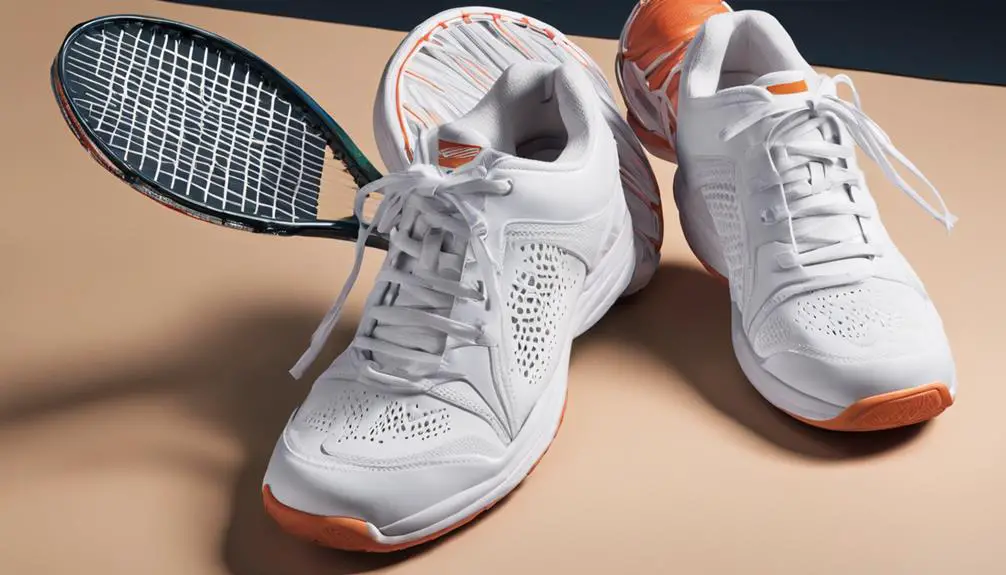
Weight and flexibility are critical factors that influence performance in both tennis and badminton shoes. The right balance can enhance your agility, speed, and overall gameplay. Here are three key considerations regarding weight and flexibility in shoe construction:
- Shoe Weight: Lighter shoes allow for quicker movements on the court. Heavy shoes can hinder your foot speed and agility, making it harder to react to fast-paced plays.
- Flexibility: A flexible shoe promotes natural foot movement, essential for executing quick lateral movements in badminton and powerful serves in tennis. Stiff shoes can restrict your performance and lead to discomfort.
- Player Preferences: Ultimately, each player has different preferences regarding weight and flexibility. Some may prefer a lightweight, flexible shoe for speed, while others might choose a more robust construction for added support.
When selecting your shoes, consider how the shoe construction aligns with your playing style. Tennis shoes often incorporate a more rigid build for stability during intense lateral movements, whereas badminton shoes emphasize lightweight materials that allow for rapid footwork.
Your choice should reflect not just the sport you’re playing but also your unique needs as a player. Think about the balance of weight and flexibility in your shoes and how they can contribute to your performance. A well-chosen pair can enhance your game while providing the comfort you need to stay focused and free on the court.
Traction Patterns
Although both tennis and badminton require quick movements and agile footwork, the traction patterns of their respective shoes are designed to meet the specific demands of each sport. In tennis, players often find themselves on varied court surfaces, such as clay, grass, or hard courts, which necessitates a shoe that provides stability and grip. Badminton, on the other hand, is typically played on indoor wooden or synthetic courts, where rapid lateral movements are essential.
The traction patterns in tennis shoes feature deeper grooves and a more pronounced herringbone design to facilitate quick stops and starts, while still allowing for smooth sliding. This design helps you maintain balance as you make those powerful serves and returns. Conversely, badminton shoes focus on a flatter, more uniform pattern that enhances grip during swift side-to-side player movement, preventing slipping and enabling agility.
Here’s a comparison of the traction patterns:
| Aspect | Tennis Shoes | Badminton Shoes |
|---|---|---|
| Court Surfaces | Varied (grass, clay, hard) | Indoor (wood, synthetic) |
| Traction Pattern | Deep grooves, herringbone | Flat, uniform pattern |
| Focus on Movement | Stability, sliding | Agility, quick pivots |
| Grip Type | Multi-directional | Primarily lateral |
| Weight Distribution | Heavier for stability | Lighter for speed |
Understanding these differences in traction patterns will help you choose the right footwear for your sport, enhancing your performance and ensuring your safety on the court.
Breathability and Materials
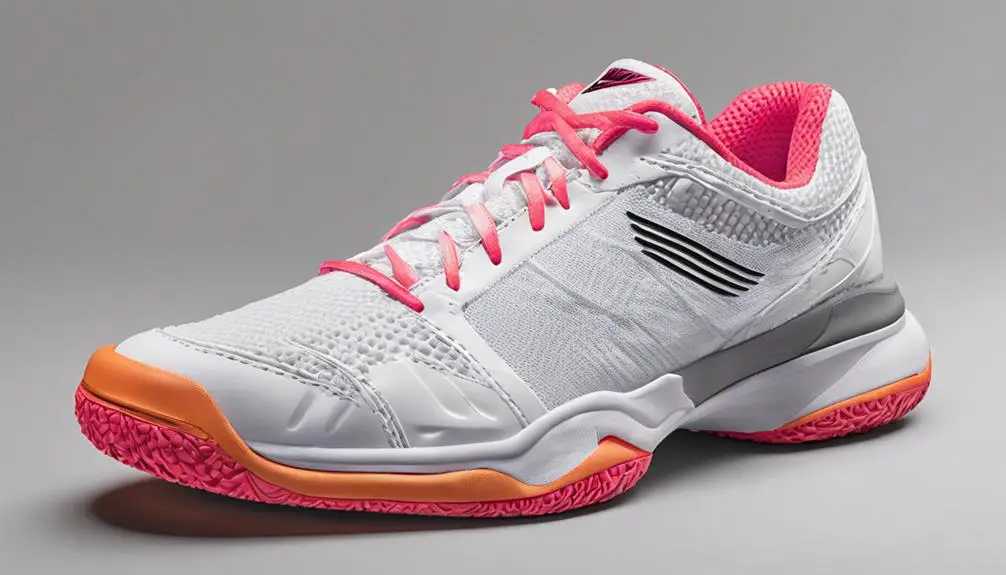
When it comes to choosing the right shoes for tennis or badminton, breathability and materials play an essential role in comfort and performance. You need to guarantee your footwear allows for adequate shoe ventilation, especially during intense matches. Here are three key aspects to reflect on:
- Material Composition: The materials used in the shoe’s upper can greatly impact breathability. Look for shoes that feature synthetic mesh or lightweight textiles, as these fabrics offer superior airflow and moisture-wicking properties.
- Fabric Technology: Advanced fabric technologies, like moisture-absorbing materials or breathable membranes, can enhance your comfort. These innovations help regulate temperature and keep your feet dry, preventing overheating during long matches.
- Sole Construction: The type of sole also affects breathability. Some shoes have perforated designs or channels that promote airflow, enhancing overall ventilation. This can be vital if you tend to sweat a lot during gameplay.
Choosing shoes with the right combination of breathability and materials will guarantee you maintain comfort and performance on the court. Breathable shoes help prevent blisters and discomfort, allowing you to focus on your game. So, next time you’re shopping for footwear, pay close attention to the fabric technology and ventilation features of your options. Your feet will thank you, and you’ll enjoy the freedom to move without distraction.
Ankle Support Considerations
Finding the right ankle support in tennis and badminton shoes can make all the difference in your performance and injury prevention. Both sports demand quick lateral movement and require you to pivot frequently, which places considerable stress on your ankles. Therefore, selecting shoes that provide adequate ankle support is essential.
In tennis, you’ll often benefit from shoes designed with a higher cut around the ankle. This design helps stabilize your ankle during those sharp turns and rapid sprints. A shoe with reinforced ankle support can help minimize the risk of sprains, allowing you to focus on your game without the fear of injury. However, too much restriction can hinder ankle mobility, which is imperative for effective movement on the court.
On the other hand, badminton shoes typically feature a lower cut for increased ankle mobility. This design allows for a greater range of motion, which is crucial for the quick footwork required in badminton. While the lower cut may seem less supportive, many badminton shoes incorporate advanced cushioning and arch support to guarantee your feet remain stable during rapid lateral movements.
Ultimately, your choice should balance support and mobility. Consider your playing style—if you prioritize speed and agility, lean towards shoes that offer freedom of movement. If you’re more of a power player needing extra support, opt for shoes with higher ankle coverage. Understanding these differences will help you select the right footwear for your sport, enhancing both performance and safety.
Durability and Wear Resistance
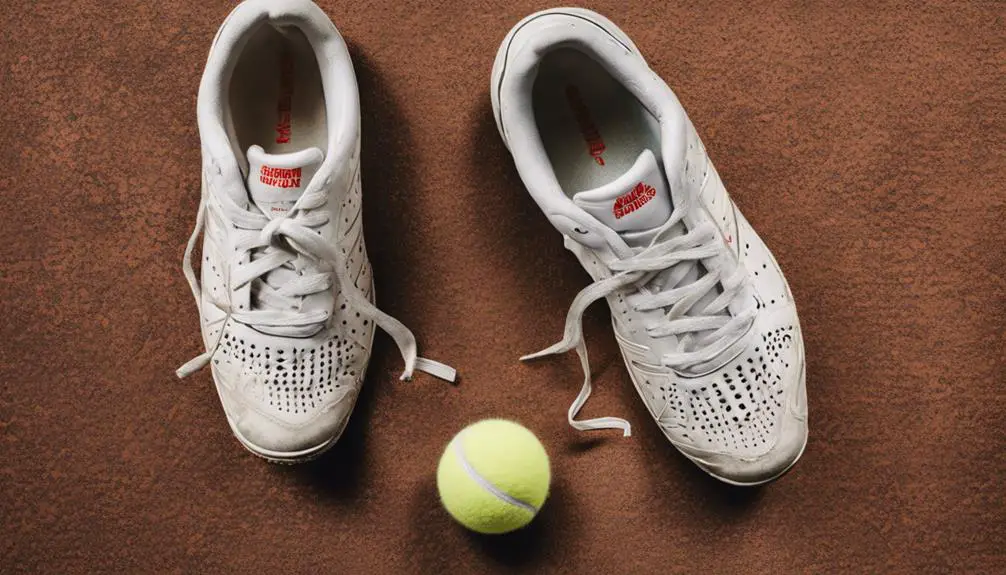
Durability and wear resistance are essential factors to keep in mind when selecting tennis and badminton shoes, as they directly impact performance and longevity. The right shoes can withstand the rigors of the sport, providing you with the freedom to focus on your game rather than worrying about the wear and tear of your footwear. Here are three key aspects to evaluate:
- Material Composition: The materials used in constructing the shoe greatly affect its durability. High-quality synthetic materials or reinforced mesh often offer better resistance against abrasions and wear, ensuring your shoes last longer.
- Outsole Longevity: The outsole is where you’ll notice the most wear, especially on different court surfaces. Shoes designed for tennis typically feature tougher rubber outsoles, crafted for prolonged contact with hard courts, while badminton shoes may utilize softer rubber for better traction on indoor surfaces, but might wear out more quickly.
- Construction Quality: Look for shoes with reinforced stitching and sturdy eyelets. These features enhance overall durability, allowing for repeated movements without compromising the shoe’s integrity.
Choosing the Right Shoe
Selecting the right shoe is vital for optimizing your performance on the court, as each sport demands specific features tailored to its unique movements and environments. When choosing between tennis and badminton shoes, the shoe fit should be your primary concern. A proper fit guarantees stability and comfort, reducing the risk of injury while enhancing your agility and responsiveness.
Tennis shoes typically have a sturdier build to support lateral movements and quick stops, while badminton shoes are lighter and more flexible to accommodate the fast-paced, multi-directional footwork found in the game. As you explore your options, consider how each shoe’s design aligns with your playing style. Pay attention to the cushioning, as this can affect your comfort during intense matches.
Personal preference also plays a notable role in your choice. Some players may prioritize lightweight shoes for speed, while others might prefer additional support for stability. It’s essential to try on various brands and styles to determine which shoes feel best on your feet. Remember that the right shoe can greatly enhance your performance, so don’t rush this process.
Lastly, consider the court surface you’ll be playing on. Different outsoles provide varying levels of grip, which can impact your agility. A shoe that performs well on indoor courts may not translate effectively to outdoor play. Taking all these factors into account will help you choose the best shoe tailored to your specific needs on the court.
Frequently Asked Questions
Can I Use Tennis Shoes for Badminton and Vice Versa?
You can use tennis shoes for badminton, but they might not perform well on indoor court surfaces. Similarly, badminton shoes aren’t ideal for outdoor tennis. Each shoe’s design optimizes performance for specific movements, so choose wisely.
How Often Should I Replace My Sports Shoes?
You should replace your sports shoes every 300-500 miles, depending on wear. Look for replacement indicators like uneven wear, loss of cushioning, or discomfort. Regular shoe maintenance tips can extend their lifespan, ensuring peak performance.
Are There Unisex Options for Tennis and Badminton Shoes?
When you’re searching for athletic footwear, unisex styles offer versatility. These shoes often feature supportive cushioning, breathable materials, and durable soles, ensuring comfort and performance, allowing you to express your individuality on the court.
What Is the Average Lifespan of Tennis and Badminton Shoes?
The average lifespan of court shoes varies; typically, they’ll last 6-12 months. Shoe materials and court surfaces greatly impact wear. Hard courts can accelerate deterioration, while softer surfaces may extend longevity. Regular inspections are essential.
Do Professional Players Have Specific Shoe Preferences?
Yes, professional players often have specific shoe preferences influenced by shoe technology and brand endorsements. They choose footwear that enhances performance, supports their playing style, and provides comfort, ensuring they maintain peak performance on the court.

